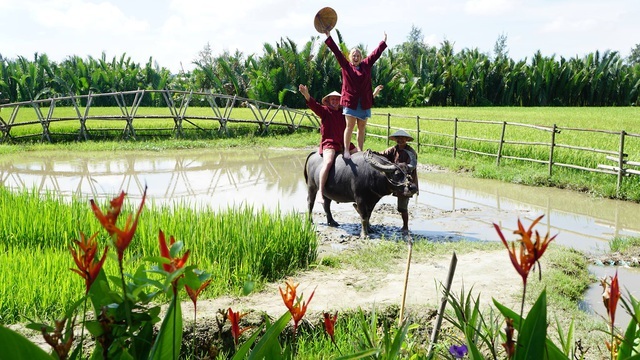These special tours have helped farmers earn hundreds of dollars.
In Hoi An, buffalo raising is a job that earns a high income, especially when tourism companies work with farmers to bring buffalos on tours.
When a delegation visits, farmers bring their buffalo to the field to guide visitors to experience buffalo riding/walking, plowing, growing rice, and other activities.
Mr. Tran Van Khoa, Managing Director of Jack Tran Tours Company, said the idea of using buffalo in tourism started in 2010. At that time, there were a lot of buffalos in Hoi An, but people only associated it with the fields, which didn’t make enough income.
“Growing up in the old town with my childhood spent on buffalo's back, it urged me to do something to help people develop their economy. Seeing that tourists enjoy the buffalo, I went to meet everyone in town personally to share with them this idea," Khoa said.
"At first, not many people had faith in the idea that buffalos can be used tourism. But now, they have helped them make fortunes," Khoa said.
According to Mr. Khoa, the buffalos are selected based on a strong and healthy body, gentle face, and capability of plowing. The ones with lazy eyes, speckled tails, and unhealthy physiques will be excluded.
The buffalos are also trained to get used to the scent of perfumes and sunscreen, or when visitors come close and ride on their backs.
“The buffalo is close to people and smart, so it is not difficult to train them. It is important to love and take care of them like a family member and especially not overwork the buffalo. The buffalo tour in Hoi An has dozens of households participating with more than 100 buffalos," Mr. Khoa shared.
Lives change thanks to the buffalos
Mr. Le Van Nhien, 54, from Hoi An said that in the past, his income from farm work was just barely enough to cover the basics. However, since the introduction of buffalos in tourism, life has changed dramatically. With four buffalos serving tourists, Mr. Nhien earns more than VND15 million (US$650) per month.
According to Mr. Nhien, one of the joys of European and American tourists when coming to Hoi An is to ride a buffalo to walk on the rice fields in the suburbs, or to plow and harrow with a buffalo. They also have farming experiences.
“Some even return to Hoi An many times just to join buffalo riding. Thanks to that, our farmers have a high income and a much better life than before,” said Mr. Nhien.
Not only Mr. Nhien, but many families in Hoi An have created high incomes. There are even people who are willing to pay companies to join hands to create this special tour.
However, for nearly a year, due to the impact of the Covid-19 epidemic, there have been no foreign visitors. With no income from tourism, villagers still maintain their buffalo herds to plow and train and wait for the return of service.
According to Mr. Tran Van Khoa, before the time of the epidemic, hundreds of tourists rode buffalos walking in the rice fields, or practiced being a farmer.
"Although there are no customers, we are still taking good care of the buffalo, waiting for the Covid-19 epidemic to end. 19 to make dollar money back," Mr. Khoa shared.
 |
||
|
Images of buffalos and rice fields are familiar to Vietnamese people
|
 |
 |
|
Foreign visitors are instructed by local people how to plow their fields. Photo taken in January 2020
|
 |
|
Foreign visitors ride buffalos, take photos. This is a special tour for visitors to Hoi An. Photo taken in January 2020 |
 |
 |
|
|
 |
|
Mr. Tran Van Khoa (left corner) and Mr. Nhien besides a buffalo. Mr. Nhien takes care of the buffalo and waits for customers to return. Photo taken in January 2021 |
 |
 |
 |
 |
|
Visitors experience watering a field, harvesting rice. Photo taken in January 2020 |
Ho Giap

Perfumed buffaloes and other strange possessions
Buffaloes in Hoi An do not work on farms, but are made-up and perfumed to bring good fortune for their owners. They are just one example of a number of strange possessions of local Vietnamese.

Millionaire story of a “buffalo boy”
A man from the southwestern region of Vietnam started his business with a female buffalo that was then extended to hundreds of buffaloes, earning him annual revenue of over a billion VND.
